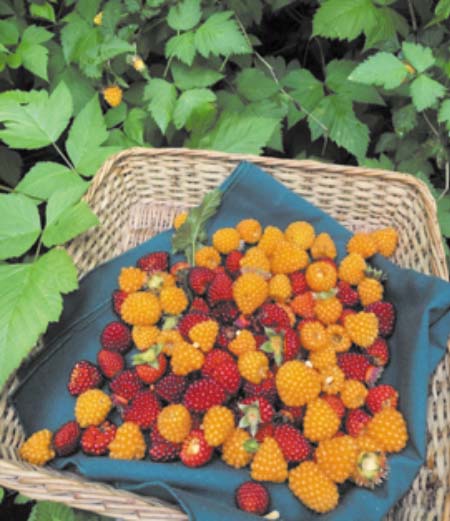
Submitted by AnneCherise Jensen
stəgʷad (Salmonberries) play an important role in the culture, traditions and way of life of many Native Americans tribes – all the way from the west coast of Northern California, through Canada, and up to Alaska. Traditionally, the Salmonberry is named after Coast Salish Native Americans fondness for eating the berries with both salmon & salmon roe. Salmonberries also play a significance in similarity in how they look a lot like salmon roe, with their orangey-pink color of the berries. The berries were generally eaten fresh, due to their high water content and difficulty to preserve – and considered a delicacy in Native American culture. To this day, salmonberries have also been known to be made into jams and jellies, and can be preserved by freezing.
Salmonberries are the earliest berry to ripen and harvest in the Spring, harvested anywhere as early May to late July depending on the elevation of the berry shrubs. Lower elevation bushes will be the first to ripen, while higher elevation will ripen later in summer. Salmonberry bushes tend to have fewer thorns than some other berry species, and typically make for a smooth and pleasant harvest. Salmonberry colors vary from dark red, to pink, to bright orange. Each color tends to have its own unique flavor, with the vibrant red known to be slightly sweeter and the orange berries slightly more tart. They are a native northwest plant, growing in abundance in marshy, wetland and forested areas with nutrient rich, unbothered soils.
Salmonberries are an extremely nutrient dense and healthy food, some may also even refer to it as a superfood. Salmonberries are packed with vitamins, minerals and antioxidants that help nourish & replenish the body. They are especially high in vitamin C, vitamin A, vitamin E, Manganese, fiber and rich phytonutrients. Here is the nutrient information on one serving (1 cup) of salmonberries. As you can see, salmonberries are an excellent source of vitamins and minerals and are a great traditional food to add to your diet this time of year.
Serving Size: 8 oz or 1 cup
Nutrient % Daily Value (% Daily Value is the percentage of the Daily Value for each nutrient in a serving of the food. The Daily Values are recommendation amounts of nutrients for individuals to consume each day for optimal health outcomes )
- Fiber 15%
- Folate 10%
- Riboflavin 11%
- Phosphorus 9%
- Magnesium 9%
- Manganese 108%
- Vitamin A 22%
- Vitamin B6 14%
- Vitamin C 23%
- Vitamin E 16%
- Vitamin K 34%

stəgʷad Salmonberry Jam recipe
Salmonberry jam is a great way to preserve and utilize a large salmonberry harvest. The jam can either be made within 24 hours after harvest, or you can freeze them and make the jam at a later time. The sugar to berry ratio is as follows; Measure the berries to find out how many cups you have and put them in a saucepan. Measure out 2/3 cup of sugar for every 1 cup of berries. For example, for three cups of berries, you will need 2 cups of sugar. For every 3 cups of berries, you will need a half a cup of lemon juice.
Ingredients:
- 3 cups Salmon Berries
- 2 cups sugar
- 1/2 cup lemon juice
Directions:
- Rinse salmon berries in light lukewarm water.
- Add salmonberries, sugar and lemon juice into a large saucepan. Your ingredient measurements may vary depending on how many berries you plan to process.
- Turn the saucepan on medium heat and mix all ingredients together. Allow to warm up the mixture for about 15 minutes.
- Once ingredients start to warm up, use a potato masher to slowly break down the berries into smaller pieces.
- Once berries are broken down – turn the heat up and allow the jam mixture to boil anywhere from 5-8 minutes. This will create a thicker consistency and the volume of the mixture should reduce to half.
- After boiling, turn on low and allow to simmer for an additional 10-15 minutes.
- Test the thickness of the jam by taking out a teaspoon and allowing it to cool.
- Once you get a thickness you like – remove from stove top and place into your favorite container.
- Refrigerate. Should last approx a year in the refrigerator.
- Enjoy salmonberry jam on some whole wheat toast, protein pancakes, or some vanilla frozen yogurt!
**This material was funded by USDA’s Supplemental Nutrition Assistance Program – SNAP. This institution is an equal opportunity provider.
Sources:
https://www.nutritionvalue.org/Salmonberries
http://nativeplantspnw.com/salmonberry-rubus-spectabilis/